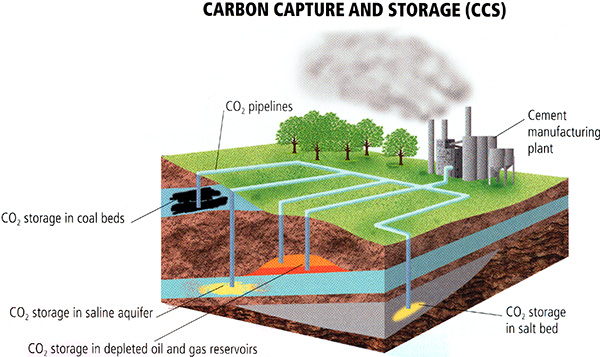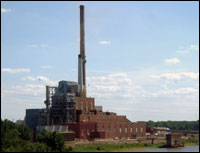Arguably the safest of the proposed geoengineering schemes, i.e., the one that is least invasive with respect to the Earth system, is carbon capture and sequestration (CCS). The main idea in this case is to prevent the carbon released during fossil fuel burning from ever getting into the atmosphere. In principle, this would allow for energy generation from fossil fuels with near zero carbon emissions. CCS is only economical when it can be applied to large point sources. In the context of energy generation, this applies almost exclusively to coal-fired power plants. CCS can also be used, however, to capture and sequester carbon emissions resulting from industrial processes, such as steel and cement manufacturing, petroleum refining, and paper mills.

© 2015 Pearson Education, Inc.
While CCS has been implemented in various forms, the first full scale "proof of concept" for CCS in the context of coal-fired power generation was known as FutureGen, and was implemented in Illinois. Once operating, FutureGen would allow for the collection of data regarding efficiency, residual emissions, etc., and form a basis for evaluating performance that would be vital if and when CCS were to be deployed commercially at a larger scale in the future. The project was funded by an alliance of the Department of Energy and coal producers, users, and distributors.
CO2 released during electricity generation from coal burning is scrubbed from the emissions and captured, compressed and liquefied, and then pumped deep into the Earth (several km beneath the surface) where it is reacted with porous igneous rocks to form limestone. This approach mimics the geological processes that bury CO2 on geological timescales, and provides a potential means for long-term geological sequestration of CO2.
CO2 is captured through a process known as oxy-combustion. This process burns coal in a pure mixture of O2 and CO2 (by first removing N2 from the air), which results in relatively pure mixture of CO2 after combustion, from which any residual pollutants (e.g., sulfate, nitrate, etc.) can be removed. The relatively pure remaining CO2 is then compressed and liquefied, and the liquid CO2 can readily be transported deep below for storage. FutureGen scientists estimate that they can annually bury roughly 1.3 million tons of CO2 (i.e., 0.0013 Gigatons carbon per year), equivalent to roughly 90% of the carbon emitted by the plant's coal burning.

Why was FutureGen considered a good choice for testing the efficacy of this CCS? The geology of the Mount Simon site in Illinois is well suited for CCS, but it is also reasonably representative of geological formations found in many other regions of the world, so that whatever is learned from FutureGen could, in principle, be applied to many other potential CCS sites around the U.S. and the world.
Geological formations that contain salt water, like Mount Simon, are ideal because of their porosity. Moreover, there is impermeable caprock to seal in CO2. The formation is deep, placing it well below the depth of aquifers that are tapped for fresh water supply.
More than anything else, FutureGen was proposed as an experiment. The FutureGen operation would have evaluated potential storage sites before deciding precisely where the liquefied CO2 would have been injected for long-term storage, based on both theoretical modeling and data collection to evaluate detailed geological information about potential storage sites. The effectiveness of the injection system would be evaluated, and there would be continual monitoring of the burial process to ensure that CO2 is indeed being sequestered and remains sequestered. Whatever is learned could, in principle, be applied to any full-scale future deployment of CCS in the U.S. and abroad.
Unfortunately, due to difficulties of committing public funds and acquiring public funds, the FutureGen project, reconstituted as the FutureGen 2.0 project, was finally suspended in February 2015 (read the article here). The Kemper County pre-combustion CCS plant in Mississippi came in $4 billion over budget and finally switched to natural gas combustion without any CCS. However, other CCS projects have started or should begin in the near future, such as the large post-combustion coal-based Petra Nova project in Texas, and the sequestration of CO2 from ethanol production into the Mount Simon formation. Other CCS projects are working with non-coal based power plants, like the CarbFix program in Iceland.

CCS might sound like a fool-proof plan for mitigating greenhouse emissions, but many of the assumptions made above may be over-optimistic. Even if the 90% rate of sequestration were correct, that would mean that 10% of the CO2 would still escape to the atmosphere, i.e., even in the best of scenarios, CCS-equipped coal-fired power plants would continue to emit CO2 into the atmosphere, just less of it. Moreover, in the event of unforeseen events, such as earthquakes, or other seismic activity, or alterations in groundwater flow, the efficacy of CCS in any particular location could be compromised. That would mean that the great initial investment made to establish the CCS site would be wasted, and the economic viability of CCS vs. other schemes to lower the carbon intensity of energy production might be undermined.
Despite all of the talk these days about "clean coal technology," such technology — in the sense that "clean" is taken to mean energy that is free or nearly free of polluting greenhouse gases — does not yet exist and remains hypothetical. Until data from experimental sites such as FutureGen have been collected and studied for some years, it will be unclear how much CO2 is actually being sequestered, and it would literally take decades until the efficacy of true long-term carbon burial could be established. Yet, we have seen that even a decade or so of additional business-as-usual greenhouse gas emissions could commit us to substantial and potentially detrimental future climate change. So CCS, despite the promise that it shows, may not be the "magic bullet" we are looking for.

